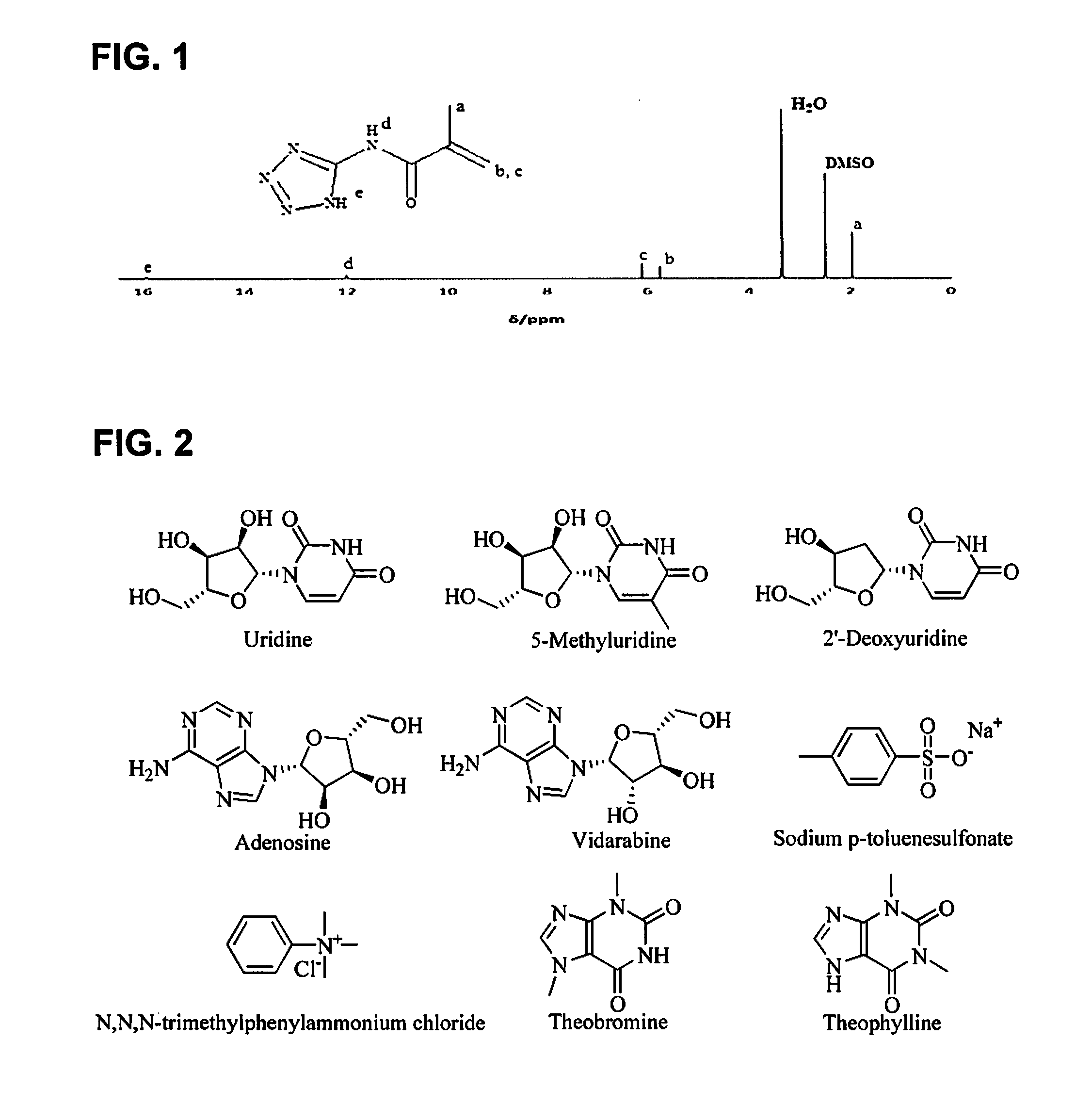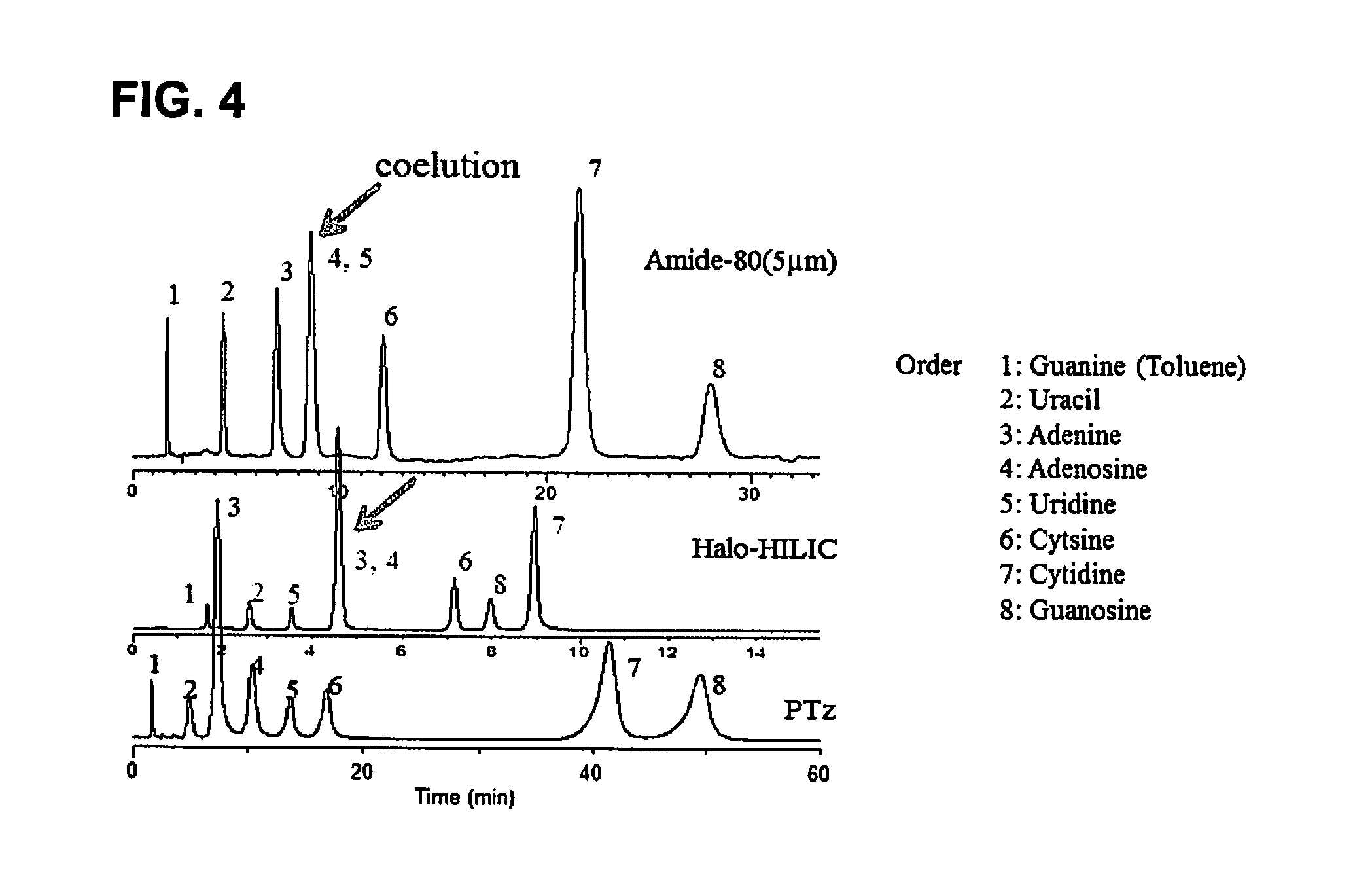Separating agent
a technology of separating agent and chromatography, which is applied in the direction of separation process, other chemical processes, chemistry apparatus and processes, etc., can solve the problems of difficult dissolution of hydrophilic compounds in ordinary nplc, difficult separation, etc., and achieve the effect of increasing the ratio of the constituent unit, increasing the molecular weight, and increasing the ability to retain hydrophilic compounds
- Summary
- Abstract
- Description
- Claims
- Application Information
AI Technical Summary
Benefits of technology
Problems solved by technology
Method used
Image
Examples
examples
[0083]The present invention is explained in more detail based on examples, but the present invention is not limited to the descriptions of the examples as long as the scope of the invention is not exceeded.
[0084]Examples of the present invention are given below.
1. Synthesis of 5-methacrylamido-1H-tetrazole
[0085](1) 3.79 mL of methacryloyl chloride was added dropwise over 30 minutes to a solution of 3.09 g of 5-amino-1H-tetrazole, 90 mL of tetrahydrofuran and 11.4 mL of water, 90 mL of water was added after 3 hours, and the mixture was stored under refrigeration.
[0086](2) The solution was suction filtered, and the white solid on the filter paper was vacuum dried.
[0087]Synthesis of 5-methacrylamido-1H-tetrazole
[0088]
[0089]The 1H NMR measurement results for the prepared (meth)acrylamide monomer are shown in FIG. 1. The yield was 70%.
[0090]2. Synthesis of Tetrazole-Containing Polymer-Modified Stationary Phase (PTz)
2-1. Synthesis of 3-methacrylamidopropyltriethoxysilane (MAS), and Suppor...
example 2
Integrated Support (Monolithic Column)
1. Preparation of Porous Monolithic Silica Column
[0134]A porous silica monolith was prepared by known methods. Specifically, this was accomplished by a sol-gel process caused by hydrolysis and polycondensation of an alkoxysilane.
2. Inner Wall Treatment of Fused Silica Capillary
[0135]1N-sodium hydroxide was supplied to a 100 μm I.D.×375 μm O.D. fused silica capillary column (Polymicro Technologies), and left for 3 hours at 40° C. This was then washed with 1N-hydrochloric acid, and left for 3 hours at 40° C. Finally, this was washed successively with ultrapure water and acetone, and dried.
3. Preparation of Hybrid Monolithic Silica Capillary Column
[0136]20 ml of 0.01 N acetic acid was added with ice cooling to 0.9 g of polyethylene glycol (PEG) and 2 g of urea, and stirred for 30 minutes. 9 ml of an alkoxysilane mixture (3:1 vol / vol) of tetramethoxysilane and methyltrimethoxysilane was added dropwise, and stirred for 30 minutes. After being heated ...
PUM
| Property | Measurement | Unit |
|---|---|---|
| molecular weight distribution | aaaaa | aaaaa |
| concentration | aaaaa | aaaaa |
| concentration | aaaaa | aaaaa |
Abstract
Description
Claims
Application Information
 Login to View More
Login to View More - R&D
- Intellectual Property
- Life Sciences
- Materials
- Tech Scout
- Unparalleled Data Quality
- Higher Quality Content
- 60% Fewer Hallucinations
Browse by: Latest US Patents, China's latest patents, Technical Efficacy Thesaurus, Application Domain, Technology Topic, Popular Technical Reports.
© 2025 PatSnap. All rights reserved.Legal|Privacy policy|Modern Slavery Act Transparency Statement|Sitemap|About US| Contact US: help@patsnap.com



